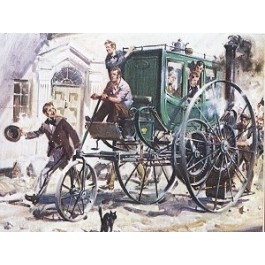On Christmas Eve 1801 in West Cornwall (UK) an engineer called Richard Trevithick took his new steam vehicle, ( or the “Puffing Devil” as it became known) out for its first test run. After a number of years research, Trevithick had developed a high-pressure engine powered by steam. His vehicle was no more than a boiler on 4-wheels but it took Trevithick and a number of his friends half a mile up a hill. The vehicle’s principle feature was a cylindrical horizontal boiler and a single horizontal cylinder let into it. The piston propelled back and forth in the cylinder by pressure from the steam. This was linked by piston rod and connecting rod to a crankshaft bearing a large flywheel.
The vehicle was used for several journeys until it turned over on the unsuitable trails that were used for pack horses in Cornwall at that time. After having been righted, Trevithick and crew drove it back to Camborne and retired to a hostelry.
The water level dropped in the boiler and the fusible plug melted, sending a jet of steam into the furnace where it blew embers all around, setting fire to the surroundings and the wooden parts of the engine. ( Trevithick’s first vehicle was recreated in 2001 when the Trevithick Society built a replica.)
The “Puffing Dragon” was the world’s first passenger car. Despite the disaster of losing his first vehicle, undeterred, Trevithick built a 3-wheeled steam carriage but this time complete with seats and a real carriage like appearance. In 1803, he drove it through London’s Oxford Street on demonstration runs and reached speeds of 8-9 mph (13 - 14 km/h). Despite the runs, nobody was interested and so when he ran out of funds, he sold the power unit to a local Miller. Trevithick’s vehicle was the first self-propelled carriage in the capital and in essence the first London bus.



